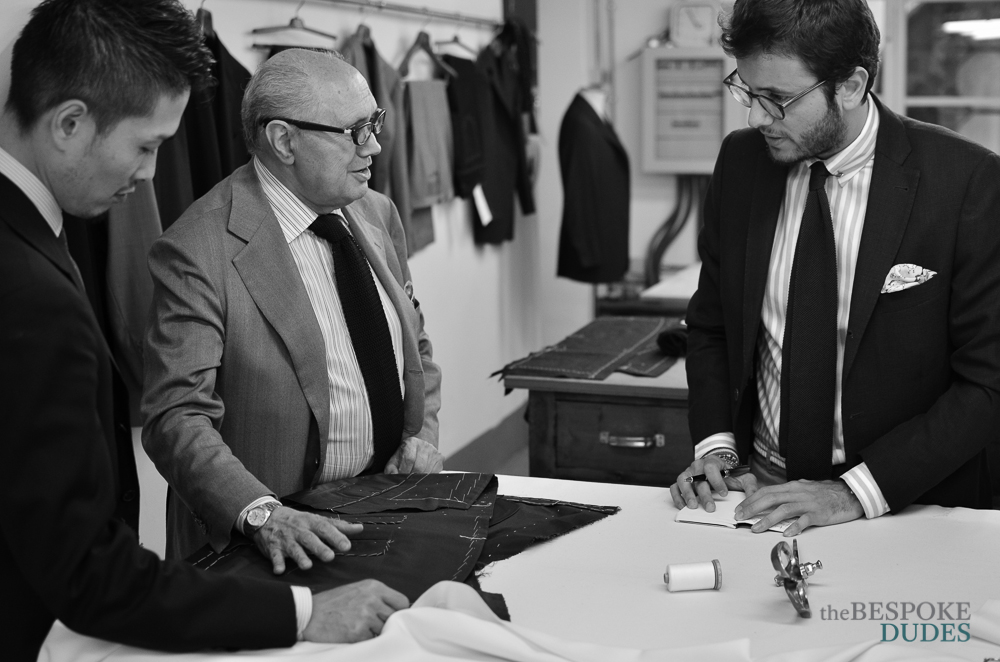With the humility of the true masters, the expertize gained during many years of work and the will to inform young people about the sartoria, the Master Antonio Liverano welcomes me in his atelier of Via dei Fossi 43r, Florence.
Con l’umiltà dei veri maestri, la perizia maturata nei tanti anni di lavoro e la voglia di informare anche i giovani sul mondo della sartoria, il Maestro Antonio Liverano mi accoglie nel suo atelier di via Via dei Fossi 43r a Firenze.
Keep reading - Continua a leggere
I start chatting with Takahiro Osaki, a.k.a. Taka, an elegant and tasteful Japanese guy, who moved to Italy at 22 to learn Italian, after having quit the previous job back in his Country. In Italy he started as an assistant in a barber shop, then as a salesguy right next to Antonio Liverano’s boutique. How did you meet Antonio? How everything started? – I ask – and he says that the encoutering happened thanks to a friend of him, who asked Taka’s help with the translation to buy a Liverano jacket. Then, Antonio’s offer. Today he is in charge of the sales and of the fabric selecton; he is working on the new “weekend line” of informal ready-to-wear clothes. He loves English fabrics, tweeds, shetlands, the bird’s eye – because more rigid – and doesn’t appreciate fancy grams. In his wardrobe the fabrics don’t go beyond Super 140’s.
Inizio a conversare con Takahiro Osaki, per tutti Taka, un elegante e raffinato giapponese che arriva in Italia a 22 anni per imparare l'italiano, dopo aver lasciato il lavoro di modellista di scarpe in Giappone. Nel Bel Paese inizierá a lavorare come shampista, poi come venditore in un negozio di abbigliamento da uomo, proprio vicino all’attività di Antonio. Come hai incontrato Antonio? Come è iniziato tutto? – gli chiedo – e mi racconta che un giorno aveva accompagnato un suo amico giapponese, che voleva acquistare una giacca di Liverano, per fargli da traduttore. Di lì a poco, nove anni or sono, la proposta di lavorare con lui. Oggi si occupa della vendita, di scegliere i tessuti e cura la nuova linea "weekend" di pronto, piú sportiva, già disponibile in negozio. Adora i tessuti inglesi, i tweed, gli shetland, l'occhio di pernice - perché piu rigido - e non gradisce le grammature troppo sofisticate. Mi dice che nel suo guardaroba i tessuti non vanno oltre il Super 140's.
These are the features of a Liverano jacket, which, as Antonio specifies, has got to be like a glove:The pocket lining is sewn on the fabric so that the stitching is visible on the front, like a patch pocketThe center-back is not cut, but folded The upper sleeve buttonhole is not functional, so the sleeve can be lengthened without losing proportions (they unstitch it and recreate it on the bottom)The frontal dart is slanted and stops at the pocket level The whole jacket is “rounded”: both the shoulder and the bottom are shaped.Few canvas insideNo wrinkles on the sleeve, only on the shirt, because they impede to iron the jacket properlyFew padding inside the shoulderThe sleeve is often unlined, especially on linen and cotton suits The lapel width varies depending on customer’s features, but never under 10 cmLow collar, to give more harmony to the person Narrow and long buttonhole, with a drop-shaped tip Queste le caratteristiche della giacca di Liverano che, a detta di Antonio, deve essere come un guanto:La fodera della tasca è cucita sul tessuto, lasciando intravedere le cuciture sul davanti, a mo' di tasca applicata. Il centro-dietro non viene tagliato, ma piegatoL'asola piú in alto è finta per poter allungare la manica senza perdere le proporzioniLa ripresa sul davanti é obliqua e non arriva fino in fondoLa giacca nel complesso é "rotonda", sia nella spalla che al fondo, che e' molto sagomatoPoca telaManica mai “a mappina” sulla giacca, solo sulla camicia. Le grinze non piacciono ad Antonio, perché la giacca va stirataPoca spallinaManica spesso Sfoderata, specialmente sui cotoni e sui lini.Ampiezza di revers in base alla taglia, ma comunque dai 10 ai 12 cm, mai di 7,8 o 9Collo basso, per dare piu armonia alla figuraAsola stretta e lunga, con punta a goccia
Antonio reminds when Florence was a sort of litmus paper: the agents used to travel with heavy bags full of fabrics. If those fabrics were accepted there, they would be bought everywhere else. Due to the premature passing of his brother, he has been leading the company for 15 years now, yet he personally cares about the creation of the papermodels. As a future project, there’s the opening of a tailoring school to teach first to sew, then to cut and make models. The trousers are outsourced and in the shop the tailors are six, one of them is a Japanese girl, willing and brilliant, who – he says – has done everything to get that job, despite his initial contrariety.
Mi racconta di quando un tempo Firenze era una sorta di cartina di tornasole: i rappresentanti viaggiavano con valigioni carichi di tessuti. Se quei tessuti piacevano a Firenze, sarebbero stati acquistati anche dalle altre boutique nel resto del mondo. Da 15 anni da solo a capo dell'azienda a causa della prematura scomparsa del fratello, Antonio tuttoggi si occupa personalmente della creazione dei cartamodelli. Tra i progetti in cantiere c’è quello di aprire Oltrarno una scuola per sarti, che insegni prima a cucire e poi, in un secondo momento, a tagliare e fare i modelli. I pantaloni sono esternalizzati e in bottega ci sono sei sarti, di cui una ragazza giapponese, volenterosa e brillante, che – mi racconta – ha fatto di tutto per ottenere quel lavoro da lui, riuscendo a vincere anche la sua contrarietà iniziale.
Today Liverano is a reference point for Florentine tailoring in the world: he can tout a private collection of vintage fabrics, even wider of Loro Piana’s one and has customers in Tokyo (where he is present with a corner also at United Arrows), Hong Kong (at The Armoury) and in Seoul. Antonio loves to define himself as a tailor-entrepreneur: not only mere manual executor of a suit, but also keeper of an Italian taste, freely passed on his regular customers, by recommending combinations, but also fabrics, colours and the most adequate cuts. Antonio deems necessary to educate the customer to the suit and – regarding the expensiveness of the sartoria today – he recommends to save money for just one suit per year, in order to have ten suits in ten years, that will last forever.
Oggi Liverano è un punto di riferimento per la sartoria fiorentina nel mondo: può vantare una collezione privata di tessuti vintage che supera addirittura quella di Loro Piana ed ha clienti a Tokyo (dove ha anche un corner presso United Arrows), Hong Kong (presso The Armoury) e a Seoul. Antonio ama definirsi un sarto-imprenditore: non solo mero esecutore manuale dell’abito, ma anche depositario di una cultura del gusto, che trasferisce gratuitamente ai suoi clienti affezionati, consigliando abbinamenti, ma anche tessuti, colori e tagli più adatti. Antonio ritiene neceassario educare il cliente all’abito e a chi gli dice che la sartoria oggi è lontana dai giovani, risponde consigliando di risparmiare anche per un solo abito all’anno, così da avere tra dieci anni dieci abiti, che dureranno per tutta la vita.
“How has your job changed during all this years?” – I ask – he replies that the method is always the same, he just corrects a bit the line, the lapels, the length, to update the, but about one thing he is sure: in order to cut a beautiful suit, not only you need technic, but also the heart. While he talks, I realize I have been paying a firm attention to what is saying, to not interrupt that flow of words and stories of a man who – speaking of passions - confides me that he cuddles the fabrics of the jackets he stitchs, as they were women’s bodies. Beautiful, because done with the heart.
Alla mia domanda sul se e come sia cambiato il suo lavoro in questi anni, mi risponde che il metodo è sempre lo stesso, aggiusta solo un po’ la linea, i revers, la lunghezza, per adeguarla ai tempi, ma su una cosa è categorico: per fare un abito fatto bene, oltre alla tecnica, ci vuole il cuore. Mentre mi parla, mi rendo conto che la mia attenzione per circa tre ore è stata magnetica, al punto di temere perfino di fare una domanda, per non interrompere quel flusso di parole, di storie, di aneddoti di un uomo che, a proposito di passione, mi confessa che ogni sera accarezza i tessuti delle giacche che cuce, quasi fossero corpi di donne. Belle, perché fatte col cuore.
I was wearing: Superglamourous Louis Loafers
If you like what we are doing here, please consider following us on Facebook - Tumblr - Twitter - Instagram
Ph. Credits: The Rome(ing) Shutter
A Conversation with... Antonio Liverano
16 Luglio 2013







